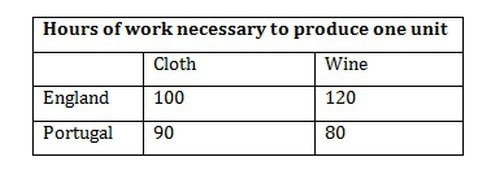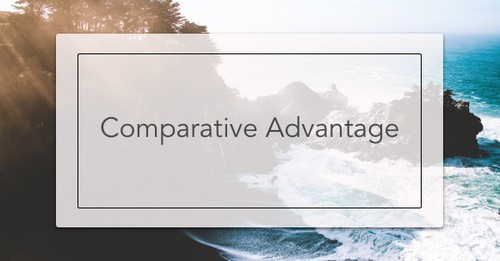Definition
Comparative Advantage is an economic advantage which happens if one country or one economy is able to produce a good or service at a lower opportunity cost than another manufacturer possibly of a different country or economy. Since this implies that a country can produce a good that is relatively cheaper than other countries, David Ricardo, in his book “Principles of Political Economy and Taxation”, suggested that the countries should specialize in producing goods and services for which they have a comparative cost advantage.
Comparative advantage can be a result of various factors such as the difference in production (capital, land, and labour), the difference in entrepreneurial skill, technology, power resources and others.
The concept of Comparative advantage has become a fundamental concept in economics and is consistently used to model international trade and the competitiveness of countries. Sometimes referred to an international division of labour, it measures competence in terms of relative magnitudes and implies an opportunity cost associated with the manufacture of one good over another. This theory implies that all countries, at all times, can benefit from cooperation and voluntary trade.
Examples of Comparative Advantage
Let us discuss this with an example taken up by David Ricardo himself explaining the comparative advantage. He considered the world economy and discusses two countries –Portugal and England – that produced two goods, having identical quality, of similar quantities.
From the above table, we can concur that Portugal is more efficient in producing cloth while England is more efficient in producing wine. Ricardo said that if each country specialized in producing what they were more efficient in, England cloth and Portugal Wine, then such a transaction will be profitable for both countries, the global production of both goods increases and thus can be consumed in a world of free trade.
Let us discuss another example of comparative advantages by factoring the cost of production. A Country X can produce wool for $15 and cotton for $1 a kilogram. Wool can be imported from other countries for $5 while Cotton can be sold to other countries for $2. The Country X, if applying the theory of comparative advantage, will certainly benefit from exporting cotton and importing wool.
The theory of Comparative Advantage can also be explained by factoring in productivity. Let us take an example where a Country Y manufactures a technically superior model of a Product A for $120 million by using 1 million hours of labour. We can understand that the productivity rate for the production of the above is $120 / hour.
The same country, however, can produce 100 units of Product B costing $0.10 with an hour of labour. The productivity rate, for Product B, is calculated to be $10 / hour. From the numbers given here, we can conclude that the country has a comparative advantage in Product A and benefits from producing Product A and importing Product B.
Absolute advantage is another factor which plays an important role in deciding Comparative advantage of a Country. Let us take an example of a country which manufactures tea at $2 per kilogram and sells it to other countries at $5 per kilogram. The same country, however, is able to produce apples for $2 per kilogram and sells them to other countries for $2.50 per kilogram. Since the ROI for producing Tea far outweighs the ROI for producing apples, farms in the country will eventually switch to producing tea only.
A very contemporary example of this can be seen in China and United States. Since labour is cheap in China, it has the comparative advantage with the United States of America. Chinese workers are able to produce simple consumer goods at a much lower opportunity cost.
On the other hand, The United States’ comparative advantage lies in capital-intensive, specialized labour and American workers are able to produce goods or investment opportunities at lower opportunity costs. If China and the United States specialize and trade along these lines, it will be beneficial for both of them.
Limitations of Comparative Advantage
- By ignoring a number of costs, the Theory of Comparative Advantage may overemphasize the benefits of specialization. Costs like include transport costs and other external costs associated with trade get overlooked in this theory and thus the benefits might be exaggerated.
- Complete specialization can prove to be harmful in the long run as some workers might be unable to transfer from one sector to another. This situation might lead to structural unemployment which is a limitation or criticism of comparative advantage.
- The theory also does not take into account the Relative prices and exchange rates. For example, if the price of product X rises relative to product Y, the benefit of increasing output of X will increase. However, this factor is overlooked in the theory of Comparative Advantage.
- The theory of comparative advantage is based on two goods, two country models. However, the real world is more complex, with countries importing and exporting many different goods and services and thus the theory has its own limitations.
- The theory is based on the basic assumption that markets are perfectly competitive and that there is perfect mobility of factors, without any transport costs or diminishing returns. This is highly impossible in the real world.
- According to Paul Krugman, the continuous application of economies of scale by global producers helps produce goods very cheaply, and thus export surpluses. The insatiable demand for choice and variety, when combined with the above, means that countries will end up producing a variety of products for the global market, rather than specializing in a narrow range of products, thus making the theory of comparative advantage almost archaic.
- Comparative advantage is also in complete contrast to the Gravity theory which says that countries incline towards having trade with similar countries with close geographical proximity. European countries, for example, are more likely to trade with similar European countries – not only because of lower transport costs but also because of similar cultural backgrounds.
Liked this post? Check out the complete series on Strategy

